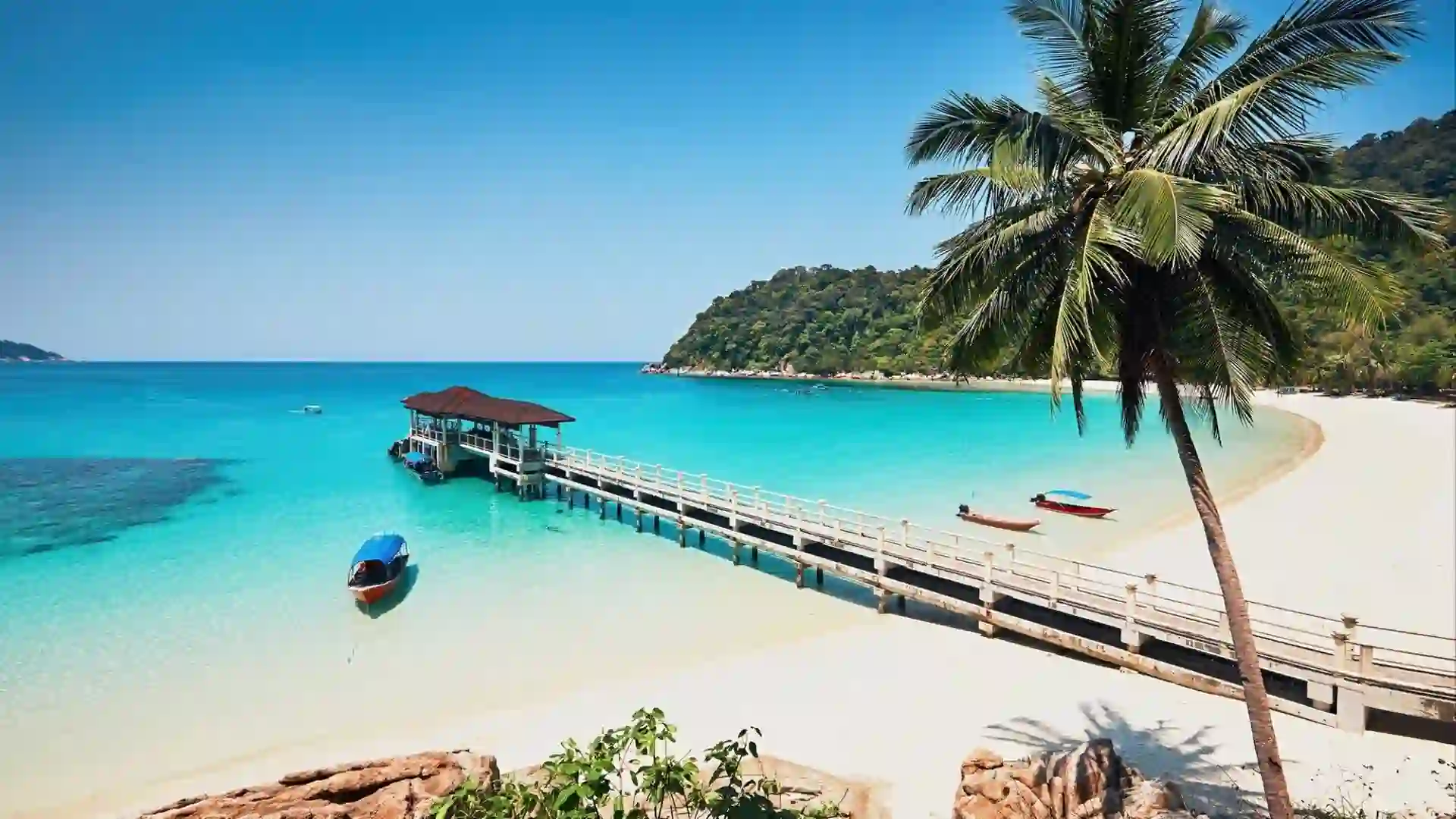
Turquoise water that feels like glass… warm sand that sticks to your feet just enough to make you smile… and a slow, salty breeze that messes with your sense of time. That’s the Perhentian Islands.
But let’s be honest for a second — getting there isn’t exactly plug-and-play. You can’t just hop on a direct flight and be sipping coconut water in an hour. Nope. There’s a bit of effort involved. A few transfers. Maybe a confused moment at a small-town jetty. But weirdly, that’s part of the magic.
This isn’t just a trip — it’s a little journey. One that starts somewhere far away (maybe Singapore, maybe Bangkok… or maybe just Penang) and winds through Malaysia’s coastal towns and forest-lined highways, ending with a splashy speedboat ride into a paradise you weren’t totally prepared for.
So, if you’re wondering how to get to Perhentian Islands — really, all the way there — this guide’s for you. We’ll walk through it piece by piece, from which airport makes the most sense to whether you’ll need to bring your own snacks for the boat. Spoiler: You probably will.
Whether you’re coming from KL, Penang, Langkawi, or even Thailand… yeah, we’ll get into that. And if you’re like me and once showed up in Kuala Besut without checking the boat schedule (don’t be me), I’ll toss in some tips to help you skip the rookie mistakes.
Let’s map it all out.
✈️ Where Are the Perhentian Islands?
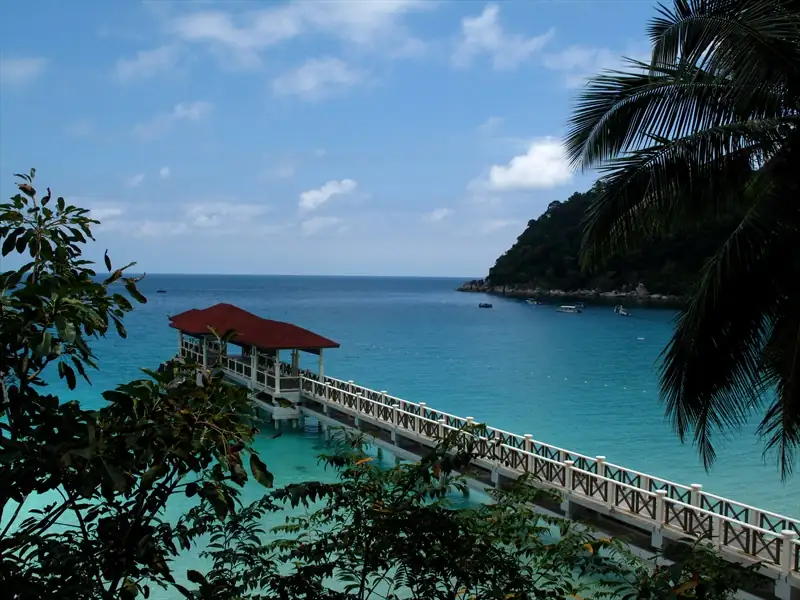
Geographic Location
So where exactly are the Perhentian Islands? They’re tucked into the northeast coast of Peninsular Malaysia, floating out in the South China Sea like someone dropped them there for safekeeping. You’ll find them off the state of Terengganu, near a tiny seaside town called Kuala Besut — which you’ll hear a lot about in this guide, by the way.
The islands themselves are part of a protected marine park, so no jet skis, no loud beachfront clubs… just coral reefs, sea turtles, and the occasional monkey swinging through the trees inland. It’s peaceful. Kinda untouched. And yeah, a little tricky to reach.
But that’s the point, right?
Main Islands Explained
There are two main islands: Perhentian Besar and Perhentian Kecil. You’ll hear locals and travelers refer to them as “big” and “small,” which fits.
- Perhentian Besar is the bigger of the two. It’s more developed, more polished. If you’re traveling as a couple, a family, or just want things like air-conditioning and functioning Wi-Fi, this is your spot. It’s also home to some solid snorkeling, peaceful resorts like Coral View Island Resort, and mellow beach cafés that somehow always smell like grilled fish.
- Perhentian Kecil is scruffier in a good way. Backpackers, solo travelers, and people who don’t mind sand in weird places tend to love it here. There’s more nightlife (think bonfire bars and beach fire shows on Long Beach), plus budget stays and dive schools like Lekkers Divers and Oh La La Divers tucked into coves you didn’t know existed. Coral Bay is the calmer side of Kecil — perfect if you want a mix of silence and decent nasi lemak.
People often switch between the islands using local water taxis. They’re fast, occasionally choppy, and always scenic.
🧭 Overview: Step-by-Step Route to the Perhentians
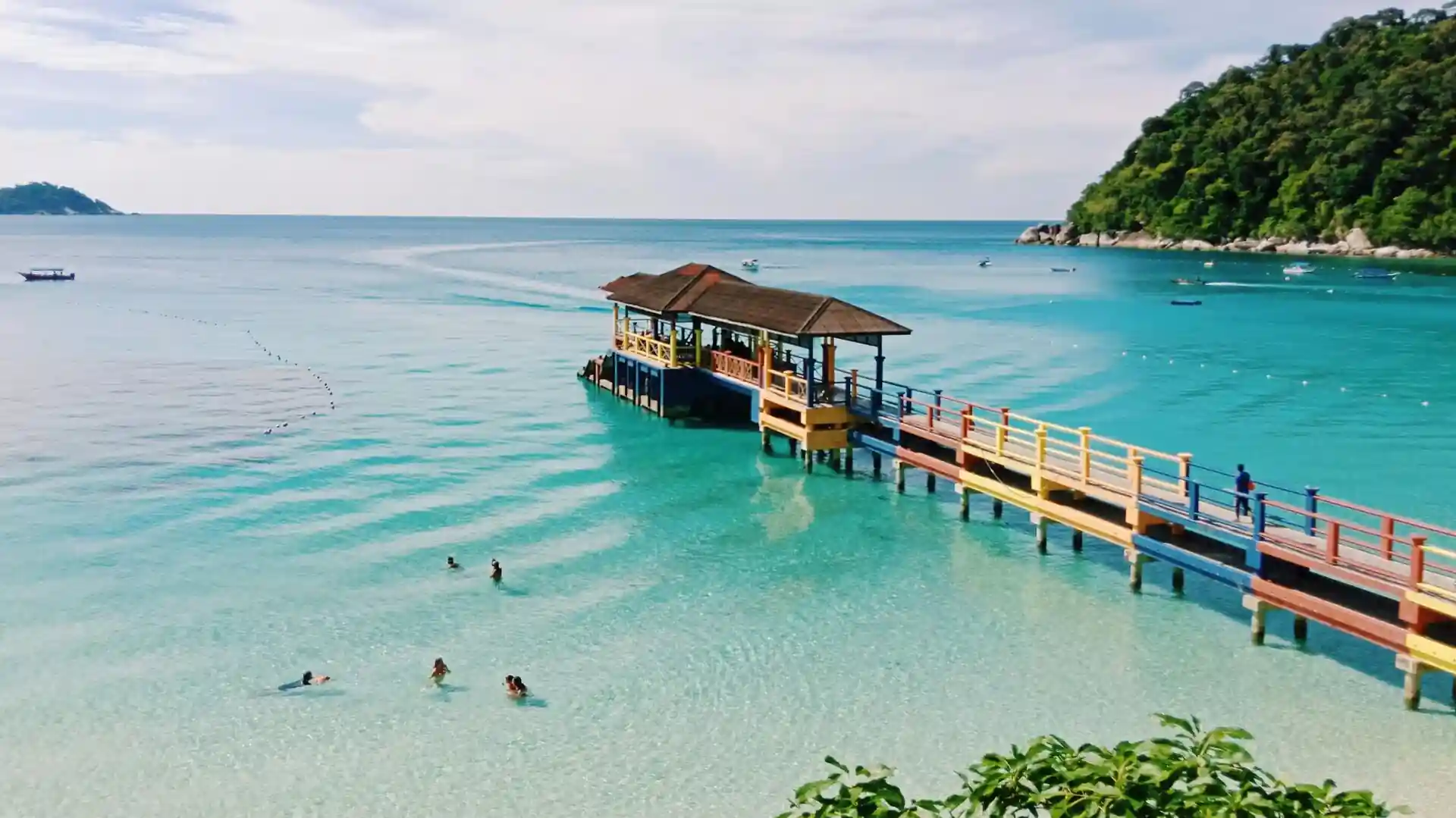
If you’re still staring at your screen thinking, Okay but seriously… how do I actually get there? — you’re not alone. Figuring out how to get to Perhentian Islands from wherever you are feels like assembling one of those puzzles where the picture on the box is a little blurry.
So let’s break it down, step by step. No fluff.
Step 1: Fly or travel to Kuala Lumpur or Kota Bharu

Most people begin in Kuala Lumpur because it’s the main international hub in Malaysia. You’ve got options here — direct flights into Kota Bharu (closest airport to the islands), or overland buses if you’re feeling patient. Alternatively, you might already be in Penang, Langkawi, or even Singapore, and we’ll talk about those routes too.
If you’re wondering how to get to Perhentian Islands from Singapore — the fastest option is to fly from Changi Airport to Kota Bharu or Kuala Terengganu, then catch ground transport to Kuala Besut Jetty. More on that soon.
Step 2: Make your way to Kuala Besut Jetty
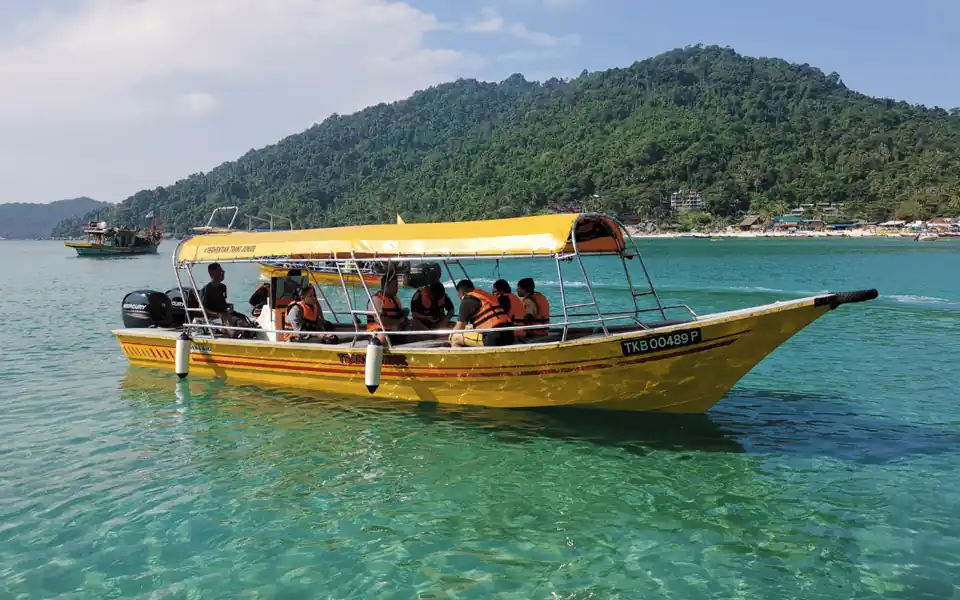
This tiny harbor town — Kuala Besut — is your official gateway. It’s where you’ll board the boat (not a ferry, more like a bouncy speedboat transfer) to the Perhentians.
There’s no airport in Kuala Besut itself, which… yeah, makes it a bit of a trek. But it also means less overdevelopment, fewer tour buses, and more wild coastline. You’ll either take a van, taxi, or shuttle here from Kota Bharu, Kuala Terengganu, or a long-haul bus if you came overland from KL.
Step 3: Take a speedboat to the island of your choice
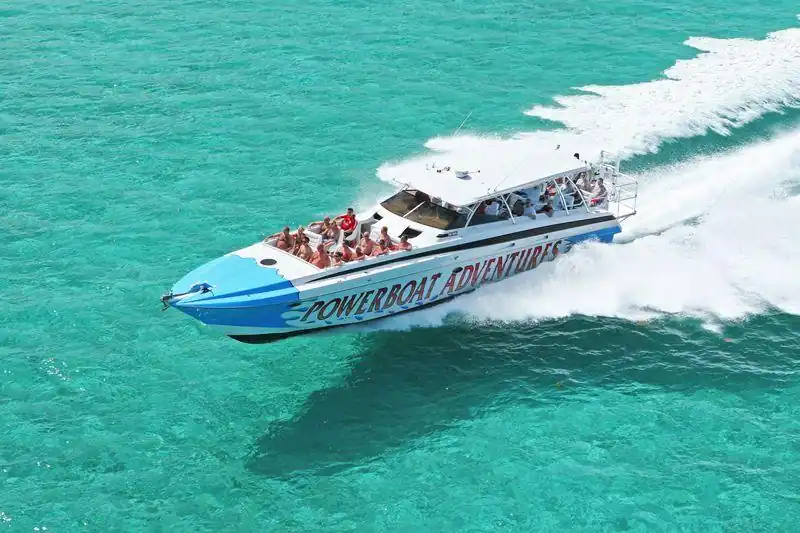
From the Kuala Besut jetty, boats run regularly (well, mostly regularly) from morning to late afternoon. If you’re picturing a lazy little ferry, think again — these are fast, noisy water cabs that shoot across the sea like they’re late for something.
Depending on the sea, the ride takes about 30–45 minutes. You’ll hop off at your chosen beach — Long Beach, Coral Bay, Turtle’s Bay, wherever you booked your stay. A lot of accommodations will help arrange the transfer, or you can sort it out right there at the jetty. Just… check the time. There are no night boats.
Here’s the simple version:
| Step | Route | How Long It Takes |
|---|---|---|
| 1 | International flight to KL or Singapore | Varies |
| 2 | Domestic flight or overland to Kota Bharu / Kuala Terengganu | 1–9 hours |
| 3 | Ground transfer to Kuala Besut Jetty | 1–2 hours |
| 4 | Speedboat to Perhentian Besar or Kecil | 30–45 mins |
Easy-ish, right?
🛫 Getting to Kuala Besut (The Gateway to the Islands)
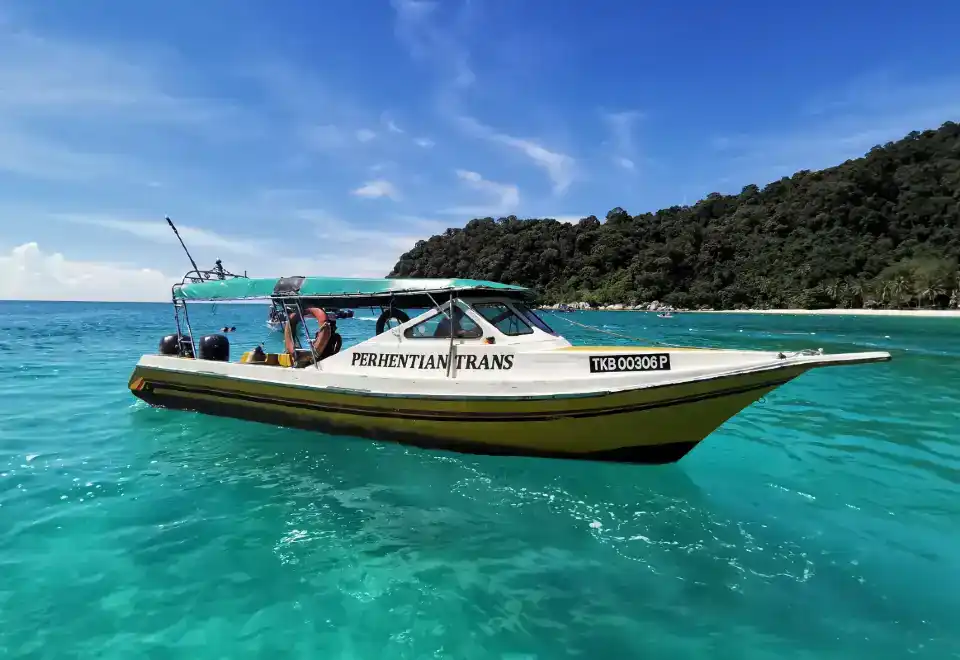
Now let’s zoom into the trickiest part — actually getting to Kuala Besut. Because no matter where you’re coming from, you’ll need to end up here before you even smell the ocean breeze.
Option 1 – Flying to Kota Bharu (Recommended)
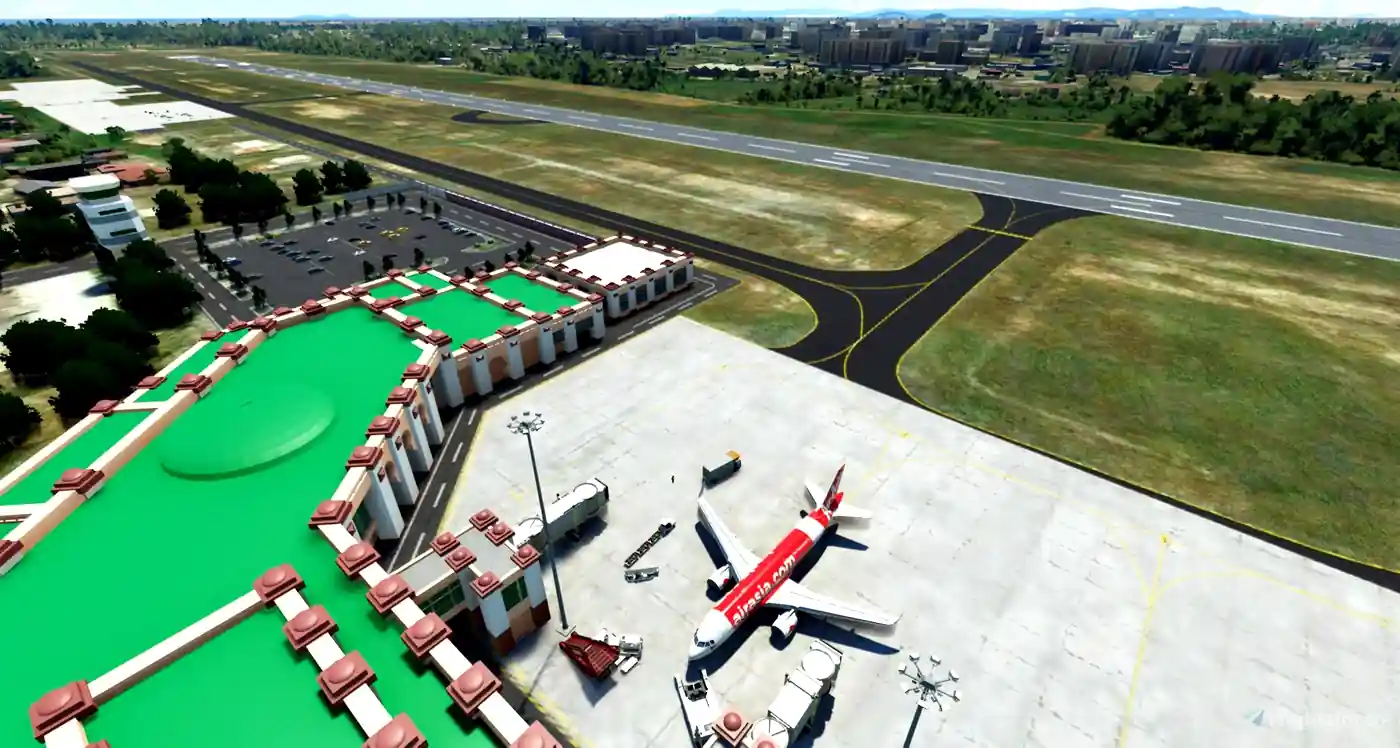
This is hands-down the most popular option. If you’re asking how to get to Perhentian Islands from KL, this route is the smoothest.
Kota Bharu, served by Sultan Ismail Petra Airport (KBR), is the closest airport to the islands. You’ll find Malaysia Airlines, AirAsia, and Batik Air running several daily flights from Kuala Lumpur, Penang, and Johor Bahru. From KL, it’s just about a one-hour hop — quick enough that your ears might still be popping by the time you land.
Flights are cheap if you book early — sometimes as low as RM 70–100. And if you’re flying in from Singapore, you’ll either connect through KL or take a direct flight to Kota Bharu via Firefly (yep, they’re still around).
Once you land, you’re about an hour away from Kuala Besut by car or van. It’s not a scenic drive exactly — more small towns and banana trees than dramatic coastal cliffs — but it’s comfortable enough.
Pro tip: Look for flight + van + boat packages offered by local operators. Some hotels bundle everything, so you don’t have to think too hard after landing.
Option 2 – Fly to Kuala Terengganu (Alternative Route)
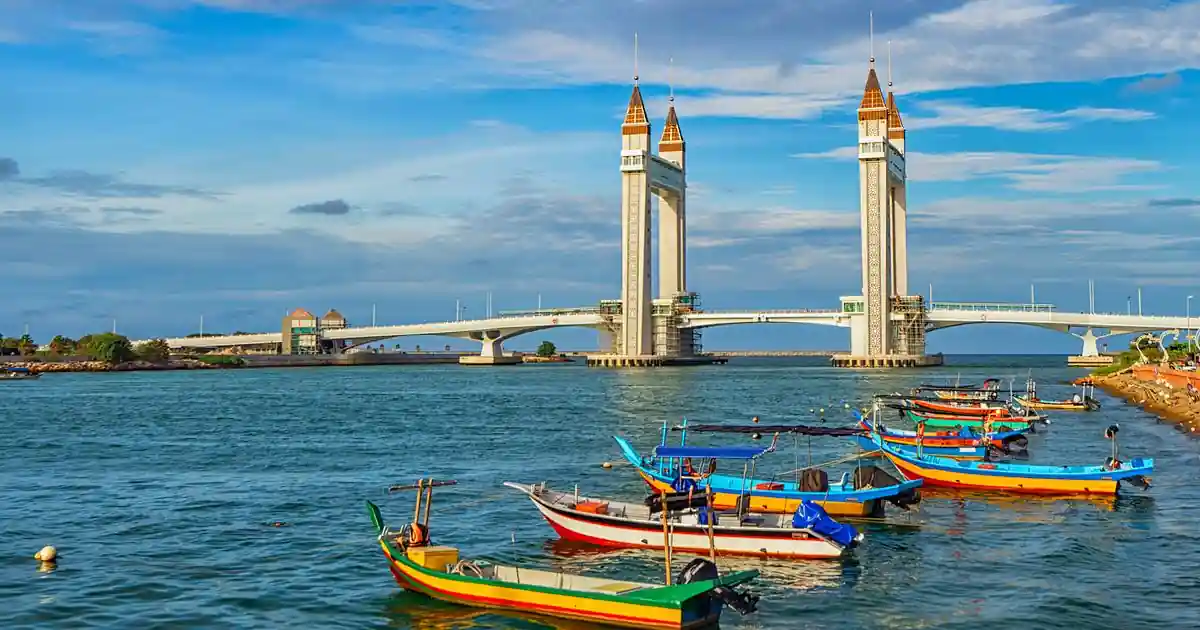
So… let’s say the flights to Kota Bharu are sold out. Or maybe you’re already exploring the east coast, soaking in places like Redang Island or Kuala Terengganu itself. In that case, flying into Sultan Mahmud Airport in Kuala Terengganu could make more sense.
This route comes up a lot when people ask how to get to Perhentian Islands from Penang or even Langkawi — since there are sometimes better connections here during peak season. Airlines like Malaysia Airlines, Air Asia, and even Malindo Air fly this route regularly.
But here’s the thing — it’s not quite as convenient as flying into Kota Bharu. From Kuala Terengganu, you’ll need to take a 1.5 to 2-hour taxi ride or arrange a private transfer to Kuala Besut Jetty. That’s a bit longer, sure, but if the flight times work out better or you’re traveling during school holidays when prices spike… it’s worth considering.
Also, don’t expect too much from the airport — it’s small and sleepy. Which isn’t a bad thing if you’re tired of giant terminals and overpriced lattes. Just… maybe bring snacks.
Option 3 – Overland from Kuala Lumpur
Alright, maybe you’re the kind of traveler who’d rather take the slow road. Or you’re already in Kuala Lumpur with time to spare and a good playlist ready. That’s when the overland route starts to make sense.
Figuring out how to get to Perhentian Islands from KL by bus or car can seem like a lot… but people do it all the time. Especially locals, budget travelers, or anyone who just wants to skip the whole airport thing.
- By bus: You’ll find regular departures from Terminal Bersepadu Selatan (TBS) in Kuala Lumpur to Kuala Besut. Companies like Perdana Express or Queen Express offer overnight rides, usually taking about 8–9 hours. It’s long, sure, but the buses are pretty comfortable — reclining seats, A/C, and the kind of sleep you get when your brain’s half-aware you’re flying through the dark.
- By car/taxi: Driving takes about 6–8 hours, depending on traffic and your tolerance for endless palm plantations. Some travelers even rent cars for this leg, drop them in Kota Bharu Town, and arrange a pickup. Not the cheapest route, but if you love road trips, it’s a scenic one. You’ll pass through small towns like Gua Musang and maybe catch a few unexpected roadside food stalls with the best street food you never planned to eat.
If you’re adventurous, there’s also the option of traveling via Taman Negara or the Cameron Highlands on your way. Yep — some people stretch it into a full loop across Malaysia. So if you’re wondering how to get to Perhentian Islands from Cameron Highlands, you’ll be looking at a 6–7 hour drive, maybe longer with stops. It’s not super direct, but… it’s a vibe.
🚐 Getting from Airport or Bus Station to Kuala Besut Jetty
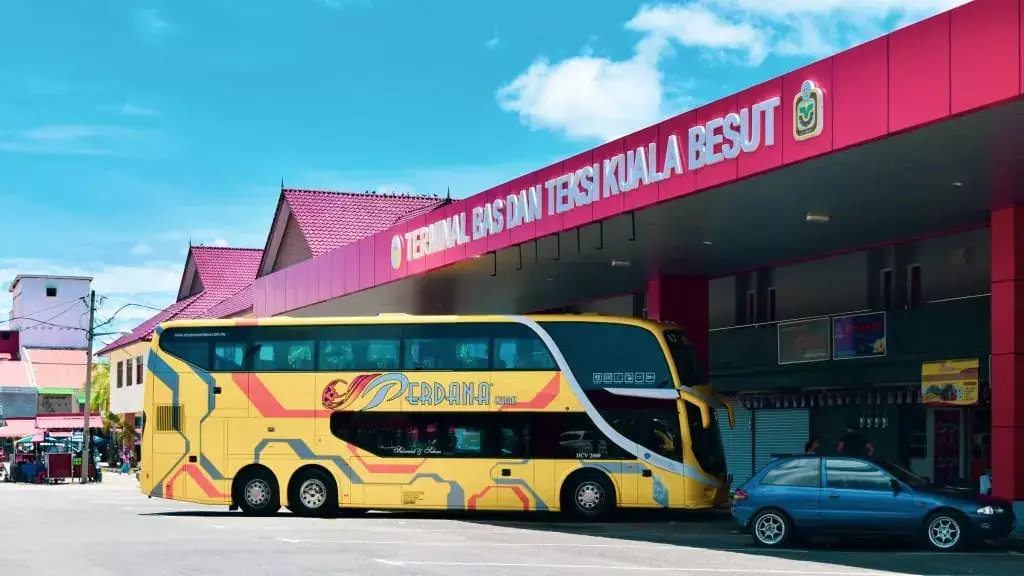
So you’ve landed in Kota Bharu, or maybe survived a bumpy overnight bus from Kuala Lumpur… now what? You’re not on the island yet — there’s still one more stretch to go before the ocean finally shows up in your periphery.
Getting to the Kuala Besut Jetty is your last bit of mainland travel, and it’s where everything starts to feel real. There’s something oddly exciting about this leg of the trip. It’s the transition point. After this? You’re officially in island mode.
From Kota Bharu to Jetty
If you’re looking up how to get to Perhentian Islands from Kota Bharu, this is it.
The airport is about an hour’s drive from the jetty, give or take depending on traffic or random detours. You’ve got a few options:
- Taxi or Grab: Easiest and most direct. Expect to pay around RM 60–80. If you’re traveling solo, maybe see if someone from your flight wants to share the ride — it happens more often than you’d think.
- Minivans/Shuttles: These are usually cheaper (around RM 35–50 per person) and can be booked in advance online or at the airport. They’re a bit slower and tend to wait around to fill up, but they get the job done.
- Public buses: Not recommended. There’s no direct bus to the jetty, and piecing together multiple transfers can get confusing fast — especially with luggage.
Some resorts or dive centers (like The Barat Perhentian or Bubu Villa) can arrange this part for you, bundling it in with the speedboat transfer and accommodation. Worth checking before you land.
From Kuala Terengganu to Jetty
If you flew into Sultan Mahmud Airport, the trip to the jetty is a bit longer — about 90 minutes to 2 hours. But the good news? The route hugs parts of the coast, and if you’re lucky, you’ll catch glimpses of beach towns and fishing boats along the way.
You can either:
- Grab a taxi straight from the airport (around RM 120–150).
- Pre-book a private car or shared shuttle.
- Or, if you’re traveling light and like figuring things out on the go… wing it and negotiate at the airport’s exit.
This route often comes up in forums when people ask how to get to Perhentian Islands from Thailand or Bangkok. Why? Because if you’re crossing the border from the south (places like Koh Lipe or Koh Phangan) and making your way into Malaysia, Kuala Terengganu is often your first major stop. From there, it’s a straight shot to Kuala Besut.
Pro Tip
Booking combo packages — especially from operators around KL, Penang, or even Langkawi — can really take the edge off this whole transfer puzzle. Some include everything: flights, vans, boats, even the marine park conservation fee. It’s not always cheaper, but it saves you from juggling five different confirmations in your inbox.
Also… and this might sound obvious, but confirm your boat departure time before you book your airport or bus arrival. Nothing quite like missing the last boat of the day and staring longingly at the sea while your luggage sits beside you like, “Told you so.”
🚤 Taking the Boat from Kuala Besut Jetty to the Islands
Here’s where the mainland ends… and things start to get salty, splashy, and just a little unpredictable.
Once you’ve made it to Kuala Besut Jetty, the only thing standing between you and the Perhentian Islands is about 30 to 45 minutes of bouncing across turquoise water in a speedboat transfer. It’s kind of chaotic in the best way — loud engines, bright sun, salty air, and someone’s dry bag flying open mid-ride. If you’ve never held onto your hat for dear life while watching sea turtles disappear under the waves… well, here’s your chance.
Speedboat Info
Boats run daily from around 8:00 AM to 5:00 PM, usually every hour or so. But “schedule” is a loose term — this is island time. Boats tend to leave when they’re full or when the operator feels like it’s time. So don’t expect strict departures like you’re catching a train at KL Sentral.
Tickets usually cost between RM 35 to RM 50 one-way, depending on your booking method and whether it’s bundled with van or hotel transfers. Some people even book round-trip combos with places like Rock Garden Resort or Senja Bay Resort — it’s worth asking.
Also, if you’re coming during peak season (say, June through August), maybe don’t assume there’ll be a spot on the next boat. Book in advance, especially if you’re arriving around midday.
Choosing Your Drop-Off Point
Here’s something a lot of first-timers miss — you need to specify where you’re getting off. Saying “Perhentian Islands” isn’t enough.
Tell the boat guys if you’re going to Perhentian Besar or Perhentian Kecil, and ideally, the exact beach or resort:
- Long Beach, Coral Bay, Tuna Bay, Turtle’s Bay, or maybe even Shark Point (yes, that’s a real stop, and no, it’s not as scary as it sounds).
- Some resorts like The Barat Perhentian and Coral View Island Resort have their own pickup boats too — a bit more direct, a lot more comfortable.
Honestly, this part can get a little hectic. The jetty isn’t huge, and when five boats are loading at once, and everyone’s holding waterproof bags and sun hats… it feels a bit like organized chaos.
Boat Safety & Packing Tips
Let’s be real — the boat ride is thrilling, but not always smooth sailing. Seas can get choppy, especially if you’re catching a late-afternoon ride. And if you’re prone to motion sickness… maybe don’t skip breakfast, but definitely keep it light.
A few helpful reminders:
- Waterproof your stuff: Seriously. The splash is real. A dry bag or at least a zip-lock for your electronics is a must.
- Sit smart: The back or middle of the boat tends to bounce less than the front. If you like spine compression, sure, go front row. Otherwise… maybe don’t.
- Boats don’t run at night: This one catches travelers off guard. If you arrive in Kuala Besut after 5 PM, you’re probably staying on the mainland until morning. Same deal during monsoon season (November to February) — boats rarely run, and most resorts close up shop.
Oh, and don’t forget about the marine park conservation fee. You’ll pay this at the jetty — it’s about RM 5–30 depending on your citizenship. It helps fund local efforts like the Turtle Project and reef protection around Coral Garden and Sugar Wreck. Tiny fee, but big impact.
🕒 Best Time of Year to Visit the Perhentian Islands
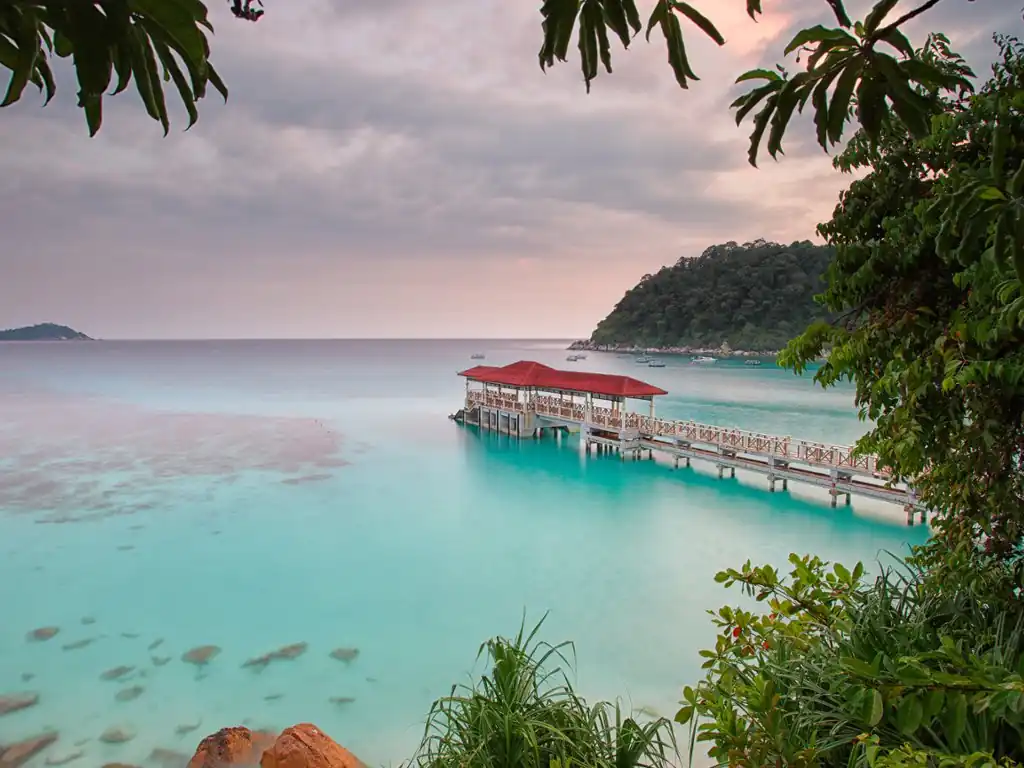
If you’re like most people planning their trip, there’s probably a question quietly haunting you… When’s the best time to go? Because it turns out, paradise has a schedule.
And the Perhentian Islands? They’re seasonal. Not in the “maybe bring a jacket” kind of way. More like… half the island shuts down during monsoon.
Peak Season (March–October)
This is when everything comes alive. Calm seas. Perfect snorkelling conditions. Dive boats lined up and ready. Turtles. Reefs. Barbecues on the beach. Perhentian Kecil and Perhentian Besar both feel like they’re buzzing… but in a barefoot, chilled-out kind of way.
If you’re wondering how to get to Perhentian Islands from Langkawi or Penang during these months, you’ve got more travel options too — better domestic flight schedules, more speedboat transfers, and combo bookings that actually make sense. It’s the easiest time to figure things out… if you plan ahead.
The downside? More people. You’ll need to book early — especially if you’re aiming for popular spots like Bubu Resort, Tuna Bay Island Resort, or anywhere near Long Beach. The dive schools like Lekkers Divers or Oh La La Divers can also get booked up fast if you’re trying to squeeze in a certification course or scuba diving trip.
Oh, and prices creep up — naturally. Still… worth it.
Monsoon Season (November–February)
This is when the islands take a nap. A very wet nap.
If you’re reading this and planning a visit during December or January… maybe reconsider. Boats rarely run. Most hotels are closed. Even if you manage to get to Kuala Besut Jetty, you might just end up staring out at gray water, clutching your dry bag with nowhere to go.
You won’t find much nightlife, and snorkelling visibility drops. The usually clear, postcard-perfect sea turns choppy, and even scuba diving schools shut down until the weather improves.
Still curious how to get to Perhentian Islands from Thailand or Bangkok during monsoon? You don’t. Not unless you’re trying to get stranded. It’s not worth the risk — especially if you’re coming from far-off places like Koh Lipe, Koh Phangan, or even up from Kota Kinabalu. Better to aim for spring.
Booking Tips
- June to August = High demand. Book your resort, speedboat, and van transfers early — even better if you can snag a combo package.
- Some of the best deals show up right before or after monsoon, around March or late October. It’s shoulder season — the sea’s calmer, and prices haven’t peaked yet.
- Use trusted local operators for real-time weather updates. Some offer flexible bookings that let you adjust last minute — helpful if you’re connecting from places like Taman Negara or Cameron Highlands and need a buffer in case things shift.
🧳 What to Pack for Your Trip to the Perhentians
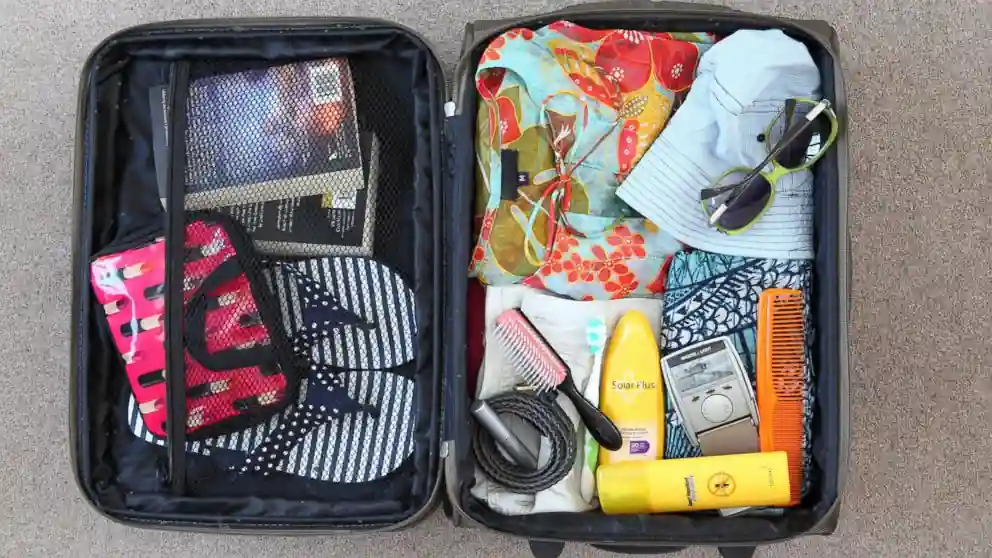
Packing for the Perhentian Islands is one of those things that sounds easy… until you’re knee-deep in sand with no ATM, no sunscreen, and your phone buried at the bottom of a soggy backpack.
This isn’t a high-maintenance kind of destination, but you do need to think ahead. Once you’re on the island — especially places like Perhentian Kecil or tucked-away corners of Coral Bay — you won’t exactly have a shopping mall to fall back on.
So here’s what’s worth bringing. And what you’ll wish you had if you don’t.
Essentials for the Journey
- Dry bag or light waterproof backpack: You’ll be getting on and off boats — often barefoot, sometimes in waist-deep water. Regular luggage doesn’t love that.
- Reef-safe sunscreen: Not just for you, but for the coral reefs. Sunscreen with harsh chemicals damages marine life (especially in places like Turtle Beach, Shark Point, or the protected zones near Coral Garden).
- Insect repellent: Mosquitos are just… around. Especially in the evening near jungle trails on Perhentian Besar.
- Motion sickness pills: Even if you don’t normally get queasy, those speedboats hit differently. Especially if you’re coming in from Kuala Terengganu or arriving during slightly rougher sea conditions.
- Snorkel gear (optional): Many resorts rent gear, but if you’re picky or planning a lot of water time (like island hopping or visiting Sugar Wreck), your own mask might be worth packing.
- Water shoes: Not a fashion statement, but trust me — they’ll save your feet on rocky beaches, coral bits, or when scrambling around places like Windmill Hill on Kecil.
Cash and Connectivity
A lot of people show up assuming they’ll just hit an ATM once they land. Except… there aren’t any. None. Not even a broken one.
- Bring cash for your whole stay — ideally in smaller bills. Many places (especially smaller chalets or warungs) don’t take cards.
- Wi-Fi is spotty, especially on Perhentian Kecil. Some cafes have decent connections, but don’t count on streaming your favorite shows. Bring a book, or if you really need to stay connected, grab a local SIM card in Kota Bharu or KLIA before heading over.
Some travelers — especially those coming from Singapore or Bangkok — assume the islands will be well-wired. They’re not. And that’s kind of the charm.
Need to know how to get to Perhentian Islands from Langkawi or Thailand with gear like diving fins or an underwater camera setup? You’ll want to travel light, and maybe ship bulky items to your resort in advance if it’s one of the higher-end places like Bubu Villa or Perhentian Island Resort. It’s doable — but easier if you plan for it.
🏝️ Where to Stay Once You Arrive
Alright. You’ve made it to the Perhentian Islands… you’ve survived the speedboat splash zone, dragged your dry bag onto the sand, and now you’re looking around thinking — So where exactly am I sleeping?
Whether you’re on Perhentian Besar or Perhentian Kecil, the range of accommodations is wider than people expect. You’ve got everything from budget bungalows that feel like Robinson Crusoe retreats to full-blown beach resorts with infinity views and tropical cocktails served in coconuts.
And honestly, where you stay shapes your experience. Especially if you’re planning on things like scuba diving, late-night fire shows, or just quietly reading under a palm tree somewhere.
Best Resorts on Perhentian Besar
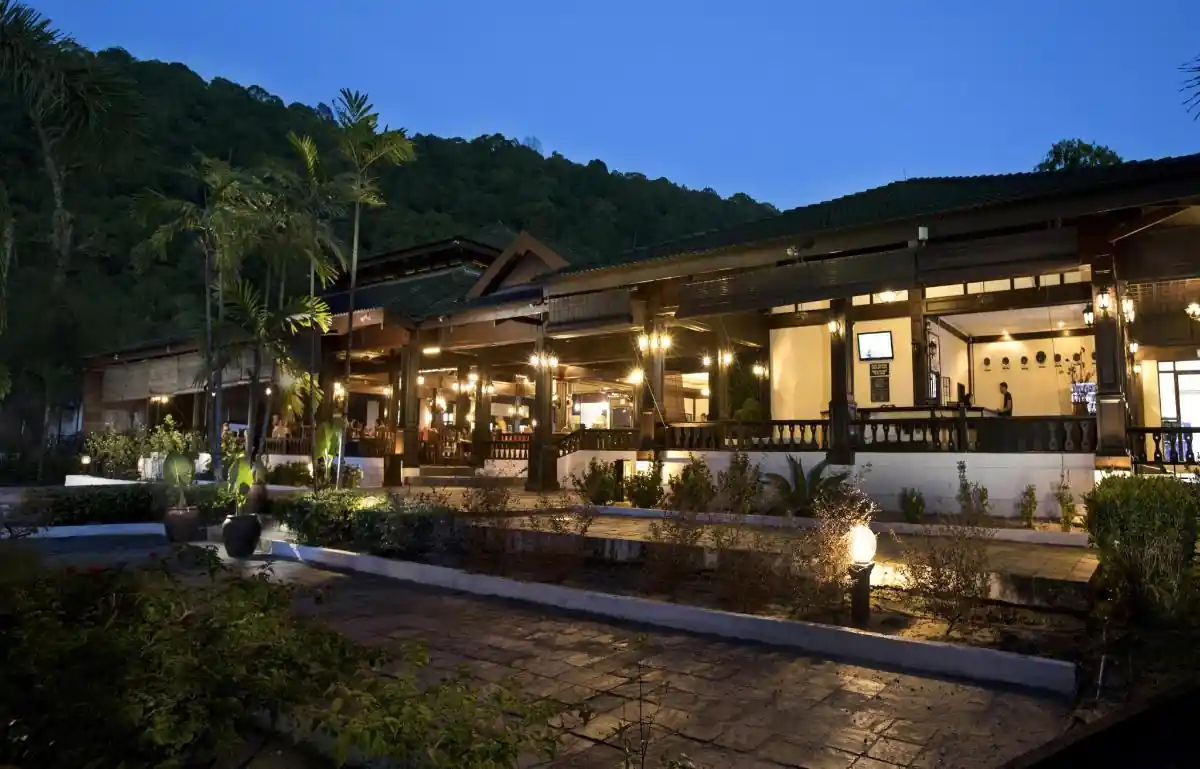
If you’re traveling as a couple, with family, or you just really want a proper bed and decent plumbing — Perhentian Besar is probably your island.
Some solid choices:
- Tuna Bay Island Resort – A go-to for mid-range comfort. It’s right on the beach, with clean rooms, sea views, and a relaxed vibe. Not flashy, but everything works.
- Perhentian Island Resort – It’s a little older, but the location near Turtle’s Bay is hard to beat. You can literally step out and snorkel with baby black-tip sharks if the tide’s right.
- Coral View Island Resort – Tucked between the jungle and the beach, and not far from dive centers. It’s quiet… almost too quiet, in a good way.
Besar is where you’d likely base yourself if you’re figuring out how to get to Perhentian Islands Malaysia with kids or parents in tow. Things are calmer here. More space. Less beach party, more beach nap.
Best Stays on Perhentian Kecil
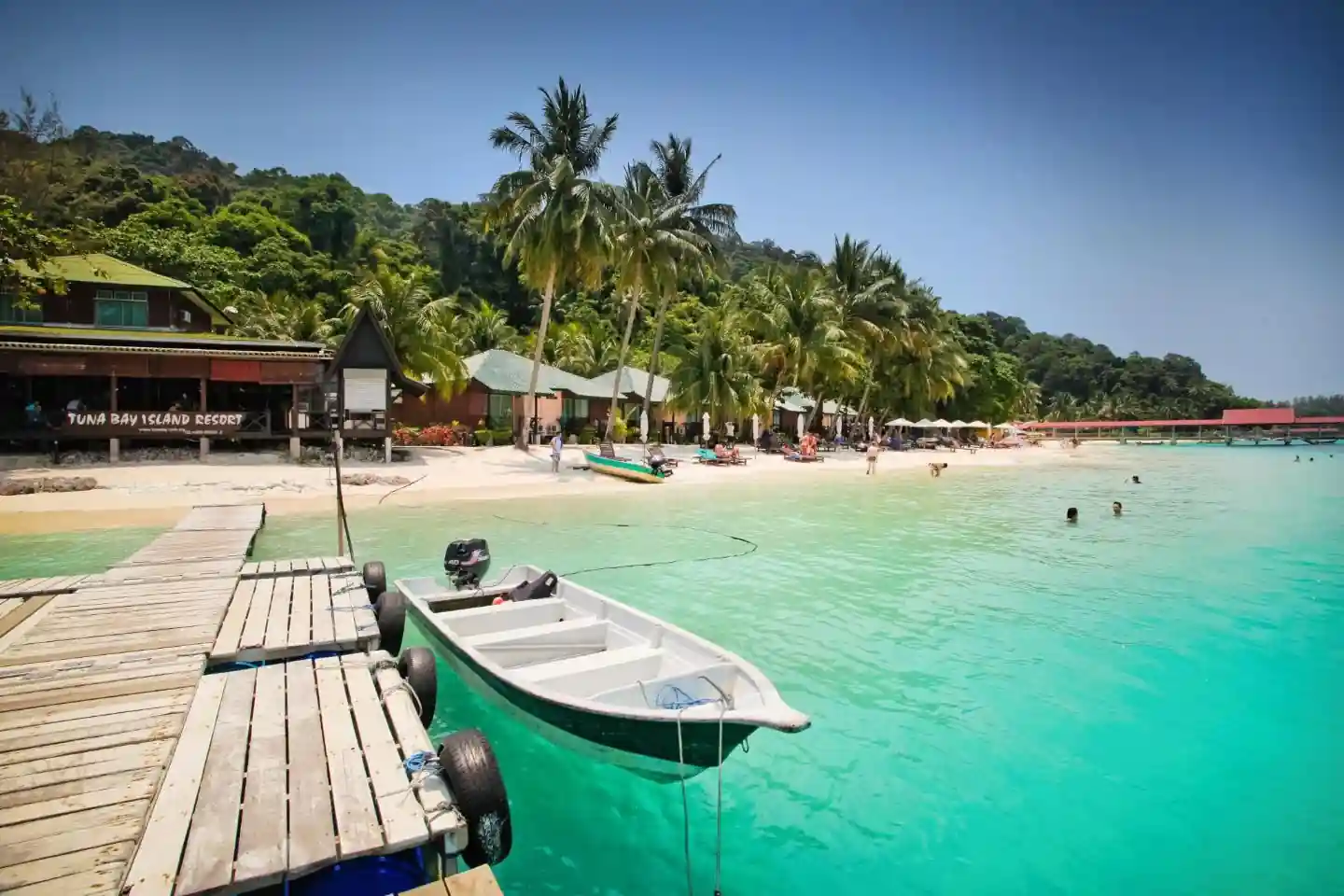
Now, if you’re more into social vibes, affordable chalets, and the kind of nights that involve bonfires and guitars… Perhentian Kecil is calling your name.
Here’s where to look:
- Bubu Resort – One of the only upscale options on Long Beach. Think air-conditioning, cocktails at sunset, and towel service. Yep, all of that exists here.
- Ombak Dive Resort – Good mix of comfort and community. They’ve got a dive center, restaurant, and even occasional movie nights. If you’re looking to dive with Oh La La Divers or Lekkers Divers, it’s walking distance.
- Budget favorites like Senja Bay Resort or Maya Guesthouse – basic but charming. The kind of places where you leave your sandals outside and forget where you put your phone because… you’re finally relaxed.
If you’re figuring out how to get to Perhentian Islands from Singapore, and you’re backpacking or doing a solo trip, Kecil tends to be the final destination. It has that rough-around-the-edges charm that somehow makes people extend their stay… even if they only packed for two nights.
Some people even hop between the two islands using local water taxis. It’s easy — and fun — especially if you’re chasing sunsets on Coral Bay or want to grab lunch somewhere different one afternoon.
🐠 What to Do After You Arrive: Top Activities
So you’re finally there… salt still in your hair, maybe a bit sun-drunk from the boat ride, and now you’re wondering — What do people actually do on the Perhentian Islands?
The answer? A lot. Or nothing at all. Depends on what you came for.
The islands are laid-back, yes, but they’re not boring. Far from it. Whether you’re the kind of traveler who chases coral reefs, or the type who wants to sip something cold while watching the sun slide into the sea, Perhentian Kecil and Perhentian Besar have something for you.
Snorkeling & Diving
This is the big one. If you came all this way and don’t go underwater… did you even go?
The Perhentians are surrounded by marine life. Think sea turtles, reef sharks, schools of electric-blue fish, and coral that still looks alive (a rare thing these days). Some of the best snorkel and dive sites are just minutes away by boat:
- Coral Garden – vibrant, shallow, and perfect for first-timers.
- Shark Point – don’t worry, they’re friendly. Mostly black-tip reef sharks cruising around like they own the place.
- Turtle Beach – less about humans, more about peaceful green turtles doing their thing.
Both Perhentian Besar and Kecil have dive centers — like Oh La La Divers, Lekkers Divers, and others that offer courses for beginners and fun dives for the more experienced. If you’ve ever wanted to get certified… this is one of the best places to do it in Southeast Asia. It’s affordable, the visibility is great, and the dive sites are genuinely memorable.
Hiking Trails & Viewpoints
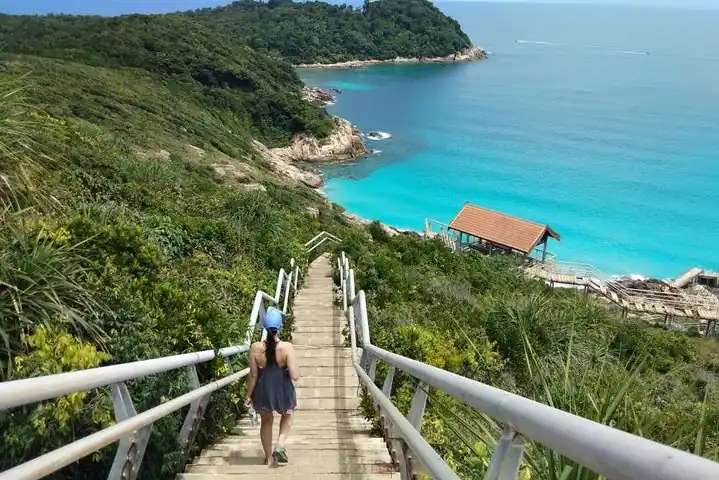
This part surprises a lot of people. For such chill beach islands, there’s a lot of greenery — and a few decent jungle trails if you feel like stretching your legs.
- Windmill Hill on Kecil is the standout. It’s a sweaty hike, not gonna lie, but the views at the top? Unreal. You’ll see the sea spread out in every direction, and if you time it around golden hour… it feels like you’re in some kind of nature documentary.
- Besar has shorter jungle paths connecting resorts and beaches. It’s not hard-core trekking, but you’ll still want decent sandals or water shoes. Especially after rain.
Some travelers who figured out how to get to Perhentian Islands from Cameron Highlands or Taman Negara often crave this kind of in-between adventure — not quite a rainforest expedition, but enough to remind you you’re not just here to lounge.
Nightlife & Dining
Okay, don’t expect full-blown beach clubs or neon-lit bar crawls. But the nightlife on Kecil — especially around Long Beach — has a low-key magic to it.
After dark, fire dancers hit the sand. Music drifts from small open-air bars. Cold beers show up next to grilled seafood, and if you’re lucky, a local might invite you to sit and chat for a while. There’s a rhythm here — not loud, but alive.
For quieter evenings, Coral Bay or spots on Besar are ideal. Candle-lit dinners, stars overhead, and waves as your soundtrack.
Oh — and don’t sleep on the street food. Some stalls serve up amazing local dishes: grilled fish, satay, coconut pancakes. Simple but good. Especially after a long day in the sun.
Want to explore more? There’s island hopping to nearby spots like Rawa Island, Lang Tengah, and even Pulau Redang National Marine Park. It’s easy to arrange with local boat guys. No over-planning needed — just ask around once you’re there.
🧭 Tips for a Smooth, Hassle-Free Journey
Getting to the Perhentian Islands isn’t complicated… but it’s also not quite plug-and-play. There are just enough moving parts — flights, vans, boats, weather, and random delays — to make things unravel if you’re not at least a little prepared.
Here’s how to keep your travel day from turning into a what-the-heck-happened kind of story.
Booking Combo Packages
Honestly, this might be one of the most underrated ways to avoid stress. Whether you’re figuring out how to get to Perhentian Islands from Singapore, or you’re starting in Kuala Lumpur, a combo package that includes transport + boat + hotel can save you from juggling five different bookings and praying they all sync up.
Some travelers even book routes like how to get to Perhentian Islands from Penang or Johor Bahru using third-party platforms or local operators that handle everything from the Terminal Bersepadu Selatan bus ride to the speedboat transfer from Kuala Besut Jetty.
Is it always cheaper? Not necessarily. But is it easier? 100%, yes.
Confirm All Times & Pickups
It sounds basic, but it’s weirdly easy to mess this up.
- Always double-check your boat time. Especially if you’re flying into Kota Bharu Airport or Sultan Mahmud Airport. The last boat usually leaves around 5 PM… and they don’t wait.
- If your scuba diving school, resort, or water taxi is picking you up, message them the day before. Sometimes they forget. Sometimes you forget. Either way, confirming things saves headaches.
This matters even more if you’re traveling through places like Kota Bharu Town or arriving via border crossings from Thailand — which, yeah, people do. (If you’re Googling how to get to Perhentian Islands from Bangkok, you’ll likely be transferring through multiple towns and may hit some unpredictable timing.)
Avoid Last-Minute Travel Plans
This is kind of the golden rule.
Because — no joke — there are no boats after dark. And if you show up late, even just by 10 minutes, you’ll either be sleeping in a basic hotel in Kuala Besut or scrambling to rebook everything the next day. Not fun.
- If you’re flying in late, consider spending a night in Kota Bharu or Kuala Terengganu and leaving fresh the next morning.
- Build in buffer time — especially if you’re connecting from places like Langkawi, Kota Kinabalu, or making a detour to see the Petronas Towers before heading east.
Also… monsoon season can shift plans fast. Even if your itinerary looks solid, a change in sea conditions might delay boats. Keep your schedule loose, especially if you’re trying to line up with island activities like the Turtle Project or a diving slot at Sugar Wreck.
📝 Conclusion: The Journey to Paradise Is Worth It
Let’s be honest. Figuring out how to get to Perhentian Islands isn’t as simple as booking a weekend getaway to a city. There’s a bit of puzzle-solving involved — flights, buses, boats, timing. And yeah, maybe it takes longer than you expected.
But once you’re standing on that white sand, the South China Sea stretching out in impossible shades of blue, and baby black-tip sharks cruising past your ankles… it hits you. The effort was part of the experience.
You made it.
From Kuala Lumpur, from Langkawi, maybe even from Thailand or Bangkok… you figured it out. You took the buses, the planes, the slightly chaotic speedboat transfer from Kuala Besut Jetty, and now you’re surrounded by coral reefs, palm trees, and sunsets that don’t even look real.
Whether you’re staying in a beachfront chalet on Coral Bay, diving at Sugar Wreck, or just sipping something sweet at a beach shack in Long Beach, you’ve arrived at one of Malaysia’s most laid-back (and still somehow underrated) island escapes.
So… ready to dive in?
💬 FAQs – Getting to the Perhentian Islands
1. Can I go from Langkawi or Penang directly to the Perhentians?
Not directly, no. You’ll need to fly or bus to Kota Bharu or Kuala Terengganu, then continue to Kuala Besut Jetty and take a speedboat.
2. Is there a ferry or only speedboats?
Only speedboats. There are no large ferries like in Redang Island or Koh Phangan. Boats run from morning until late afternoon, weather permitting.
3. Can you fly directly to the Perhentians?
Nope — no airport on the islands. The closest airport is Sultan Ismail Petra Airport in Kota Bharu. From there, it’s a 1-hour drive to the jetty.
4. Do the boats run during monsoon season?
Not really. Between November and February, service is limited or totally shut down. Most resorts close too. It’s not the time to go.
5. What’s the best way for families with kids to get there?
Flying into Kota Bharu, then taking a pre-arranged van and boat transfer to Perhentian Besar. It’s quieter and more family-friendly than Kecil.
6. I’m in Bangkok. How do I get to the Perhentians?
Fly to Kota Bharu via Kuala Lumpur or Penang, then taxi or shuttle to Kuala Besut Jetty. It’s a bit of a journey, but totally doable.
7. Are there pet-friendly hotels on the islands?
They’re rare. Most places don’t accommodate pets, though a few budget spots on Kecil may allow it — always ask in advance.
8. Is the marine park conservation fee mandatory?
Yes. You pay it at Kuala Besut Jetty before boarding the boat — it goes toward protecting the reefs and marine life.
9. Do I need to bring snorkel gear or can I rent it?
Both work. You can rent gear at most resorts or dive shops. But if you’re picky about fit or hygiene, bring your own.
10. Is there Wi-Fi or phone signal on the islands?
Patchy at best. Some resorts offer basic Wi-Fi, but don’t count on it. A local SIM card (Digi or Celcom) may help, but expect slow speeds.






